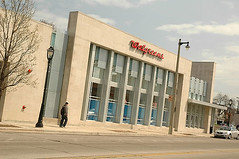Intelligent design for great cities

Milwaukee Department of City Development image. A new Walgreen's on Oakland Ave. was pushed by neighbors and the city to meet higher design standards. I will admit this is better than many of the new infill pharmacies constructed in DC by CVS and Rite Aid.
Is an article in the Milwaukee Journal-Sentinel, forwarded to us by Nigel. From the article:
... Sometimes great design happens only when you insist on it.
A comprehensive vision of city development, coupled with high standards and aspirations, is the bedrock of a world-class city and the primary thrust of Milwaukee’s recent efforts to ensure a future that is architecturally, urbanistically and economically sound.
Milwaukee’s economic future depends on our continuing ability to recognize our assets, build upon them and pursue innovative solutions to some of our most pressing challenges. And behind every great city, including Milwaukee’s renaissance, is a great plan. ...
1. Finish the plan: Everywhere is important ...
2. Raise the bar: Everything is important ...
3. Thinking outside the box
------
My "only" criticism of the article and the focus by Milwaukee is a focus on what they think of as great design, but not necessarily great "urban design" and the quality of placemaking. The Calatrava building the article calls attention to isn't a great place, from an urban design and PPS "placemaking" standpoint. Note that the City of Milwaukee Comprehensive Plan doesn't have an urban design element. Any city comprehensive plan without an urban design element is likely to be seriously lacking.
A resource to begin to understand the primacy and importance of urban design is the article by Jan Gehl: Close Encounters with Buildings.
Note that DC has a decent comprehensive plan, maybe not great, but very good. the problem is that (1) the Urban Design element should be considered the foundational element, leading other elements, because the overall built form of the city and context is more important than how specific parcels are used (the DC Urban design element is very very good); and (2) the transportation element is weak.
But DC does a piss-poor job in terms of demanding excellence in urban design generally and design specifically. The design quality of city government funded and/or produced buildings is pretty plebian.
DC should have design guidelines for all parts of the city, not just areas designated historic locally (under the purview of the DC Historic Preservation Review Board) or the Federal Interest area (National Capital Planning Commission, Commission on Fine Arts). Although the federal bodies don't seem all that focused on context either these days, and the CFA seems to think boxy glass buildings are all the rage.
Labels: urban design/placemaking



0 Comments:
Post a Comment
<< Home